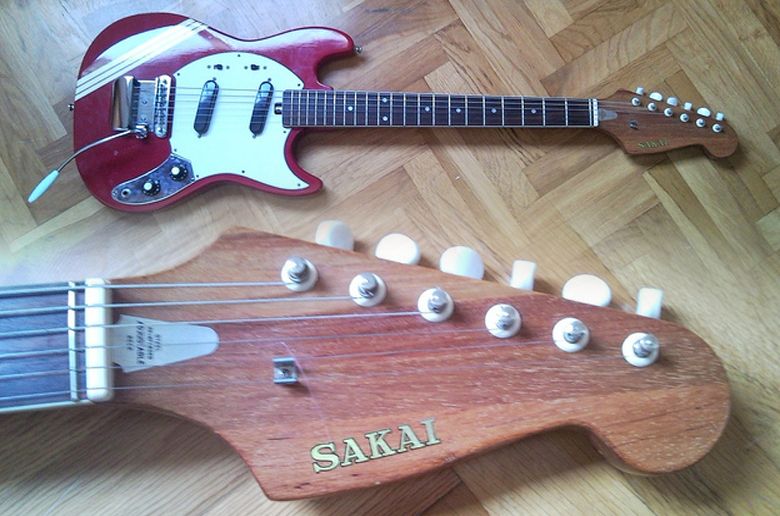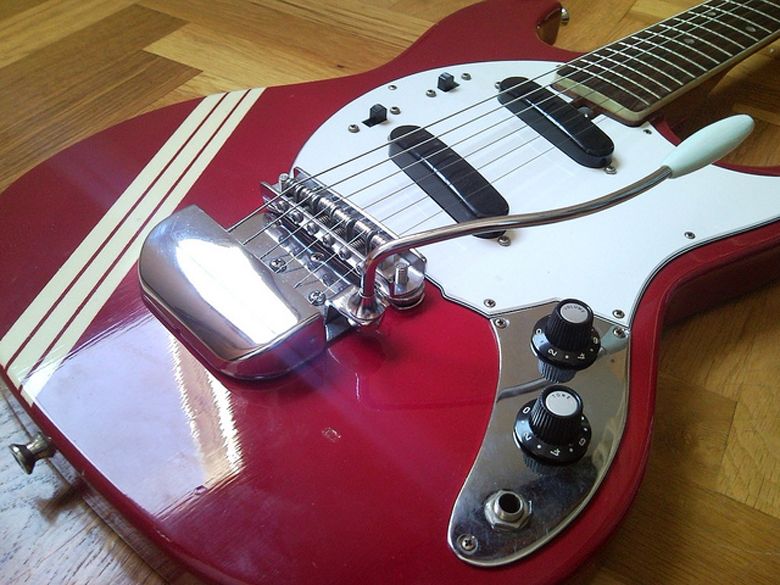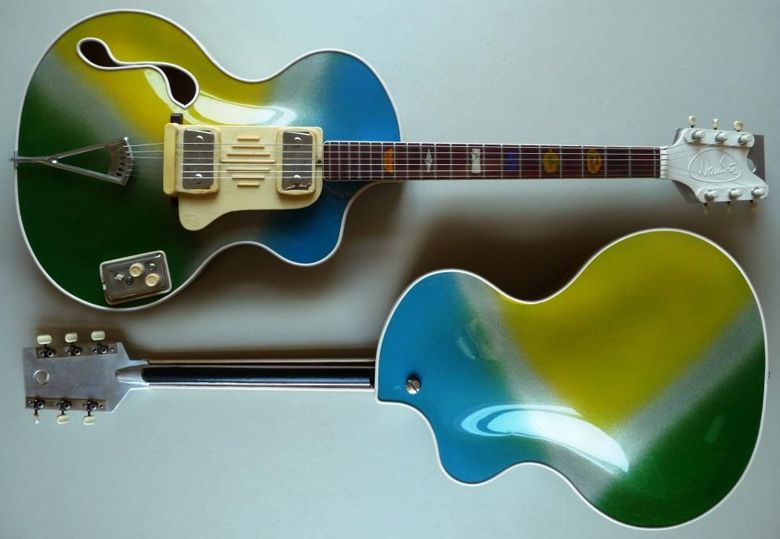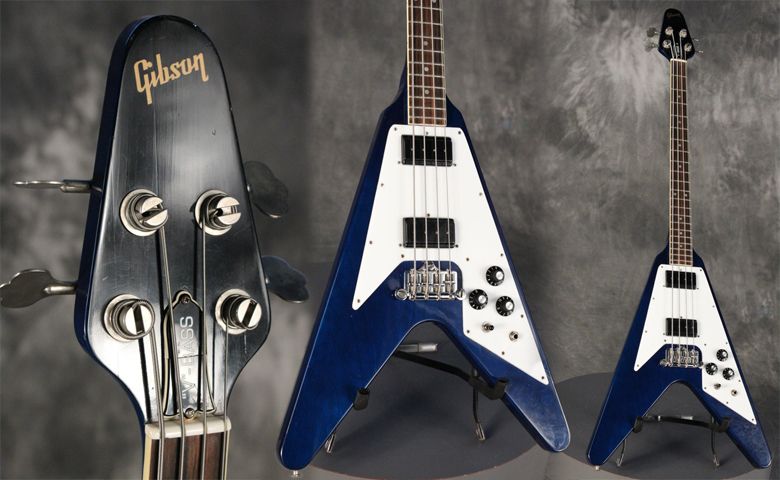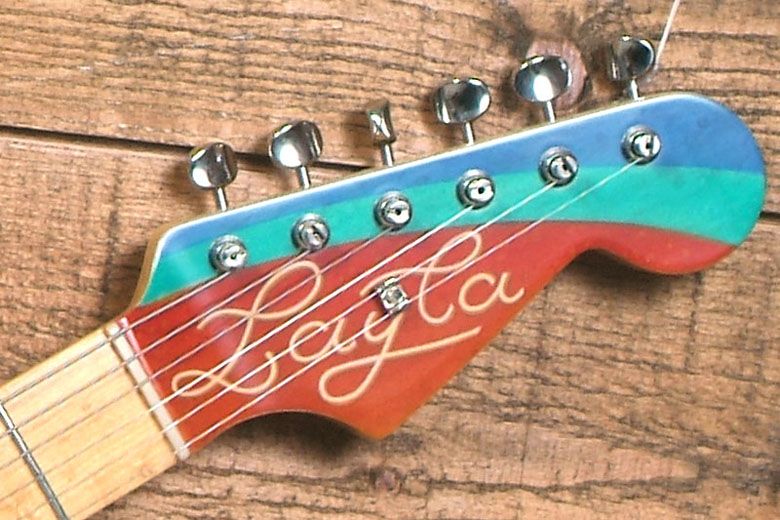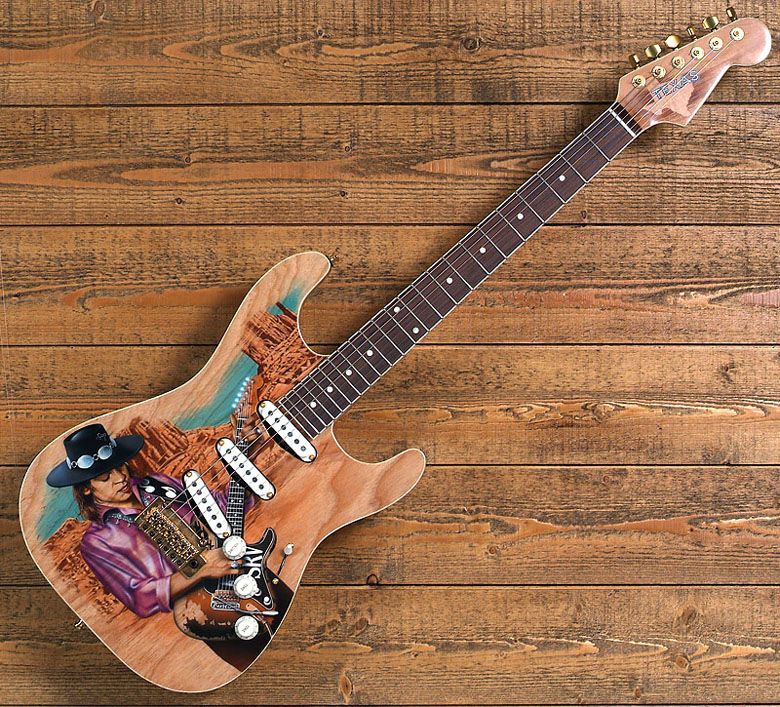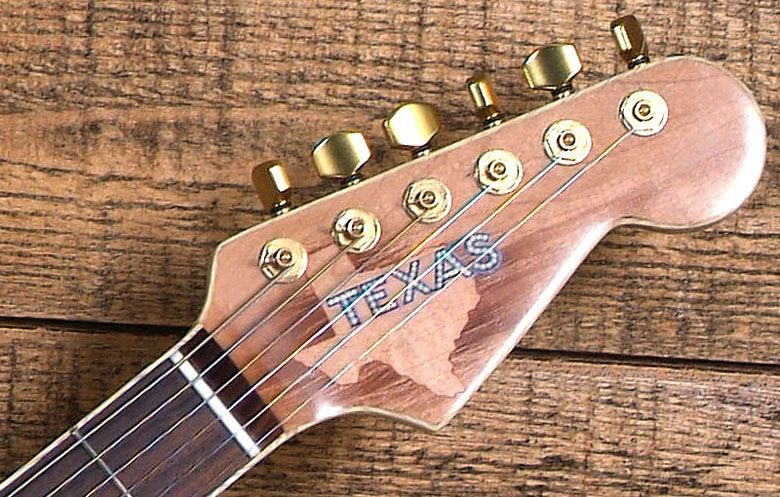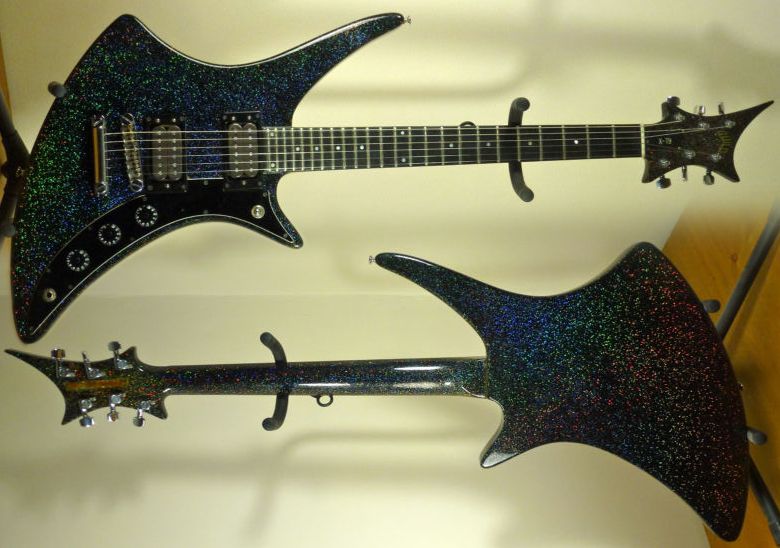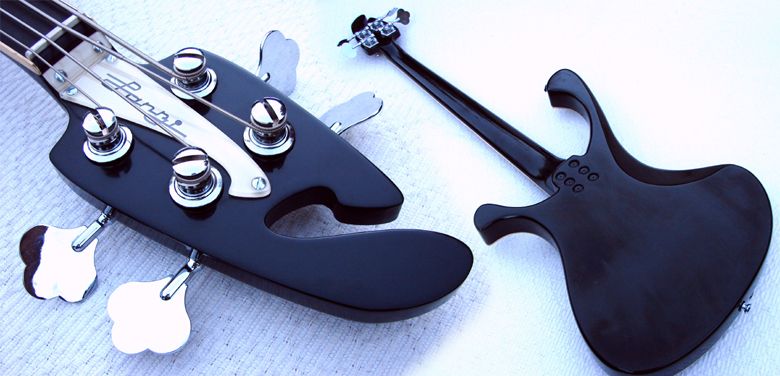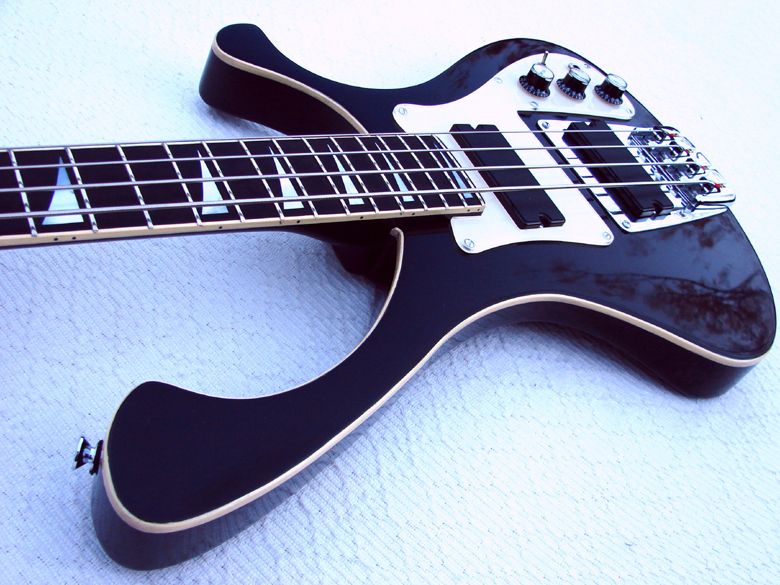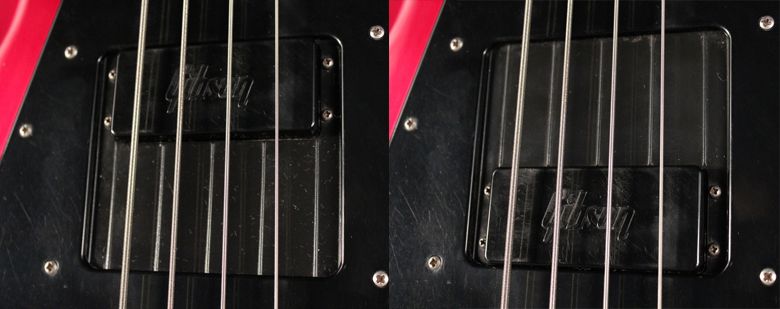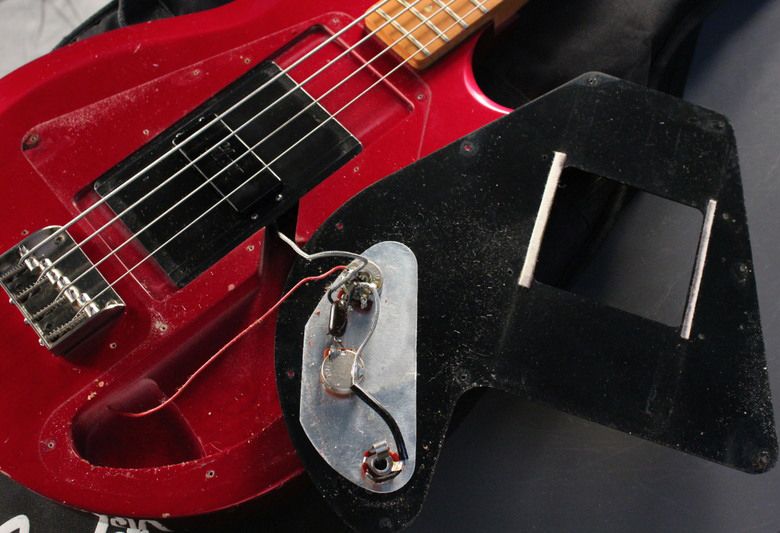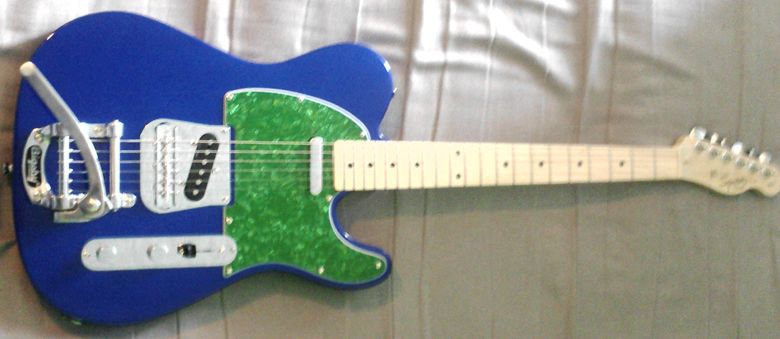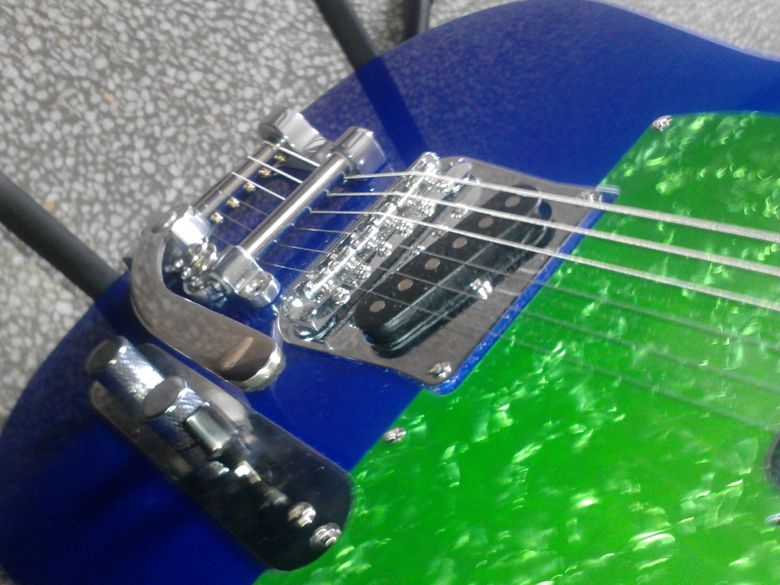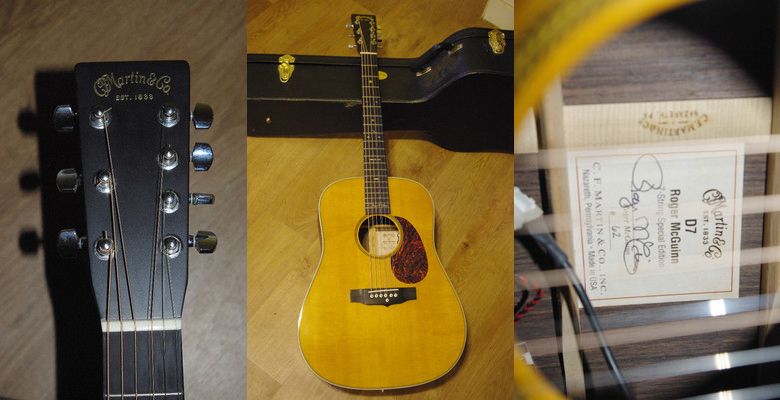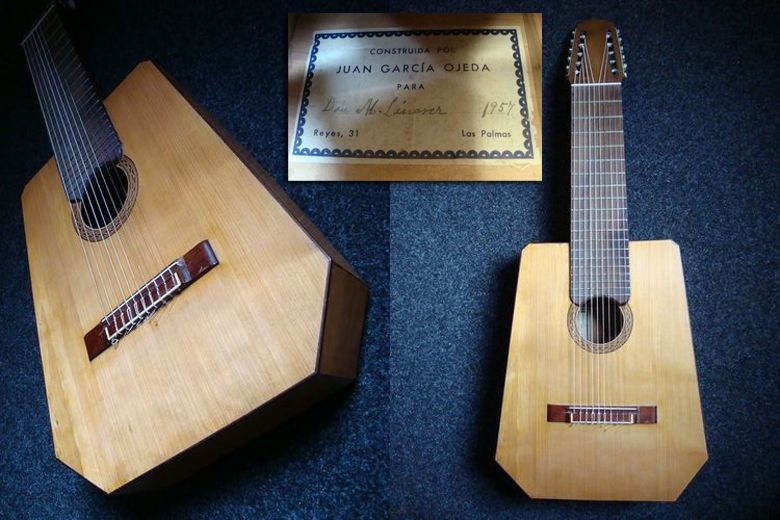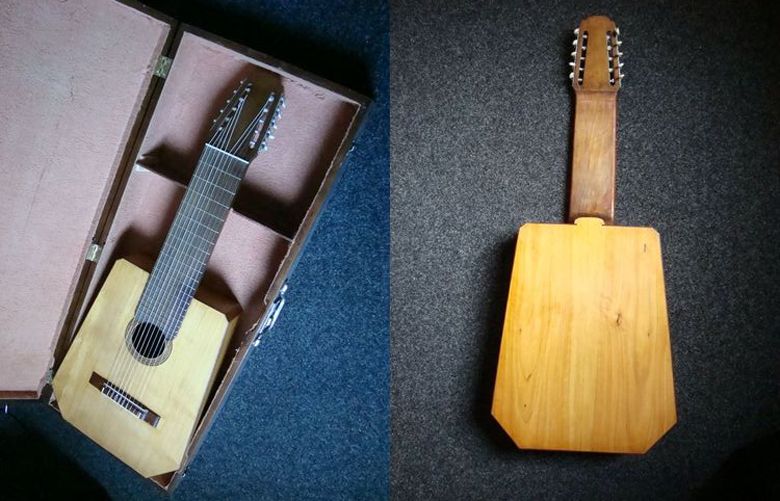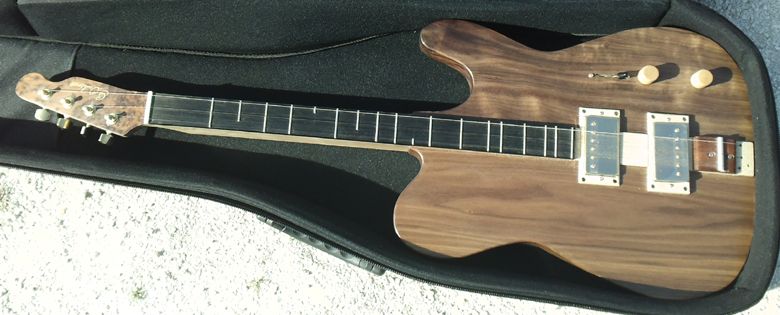guitarz.blogspot.com:
This pointy guitar looks like it could have so easily have come from the 1980s, but perhaps the lack of a locking trem - or actually a trem of any kind - gives the game away that it is actually an earlier creation from 1970s Japan. It's actually an H.S. Anderson Kite, H.S. Anderson being a brand name of Morris who also made guitars with other brandnames such as Hurricane.
Other H.S. Anderson guitars included the "Houston" (a.k.a. The Beatles Apple, although it was never played by any of The Beatles, Abba's Björn Ulvaeus was known to use one) and the "Madcat" Telecaster-style guitar favoured by Prince (before they were re-branded with the Hohner name).
The Kite looks as if it could be quite an ergonomic guitar; although not quite so curvy, its shape is not a million miles away from that of the Ovation Breadwinner and Deacon guitars. This example looks as if it has seen a lot of action over the years, bearing a lot of battle scars. It is currently listed on eBay with a Buy It Now price of $1,200.
G L Wilson
© 2012, Guitarz - The Original Guitar Blog - now in its 10th year!
Monday, 30 April 2012
Sunday, 29 April 2012
The Fender Custom Shop gets weirder: Crash Strat, Pro Junior amp and canvas set
guitarz.blogspot.com:
Here we have a Fender Custom Shop Stratocaster, masterbuilt by by Todd Krause, with matching Pro Junior amp and a large art canvass all painted by renowned graffitti artist John "Crash" Matos. The canvass features white silhouettes where the Strat and the amp were supposedly sitting when the painting was made. Strats with artwork by John Matos have been favoured by Eric Clapton in particular, and are often referred to as Crashocasters.
Apparently this is one of two such sets made circa 2007, but because of the nature of the original artwork each set could be said to be unique. I'm guessing such items are aimed squarely at the collectors' market rather than at players, although of course this are fully functioning musical instruments. It does seem very far removed from Leo's original vision of "everyman" production line guitars, but I guess that's the nature of the "art".
I'm not sure how it is supposed to be displayed. Would you just have the whole shebang lying on the floor or would you have to somehow fix the guitar and amp to the wall behind the canvas?
Currently listed on eBay with a Buy It Now price of $12,999.95.
G L Wilson
© 2012, Guitarz - The Original Guitar Blog - now in its 10th year!
Here we have a Fender Custom Shop Stratocaster, masterbuilt by by Todd Krause, with matching Pro Junior amp and a large art canvass all painted by renowned graffitti artist John "Crash" Matos. The canvass features white silhouettes where the Strat and the amp were supposedly sitting when the painting was made. Strats with artwork by John Matos have been favoured by Eric Clapton in particular, and are often referred to as Crashocasters.
Apparently this is one of two such sets made circa 2007, but because of the nature of the original artwork each set could be said to be unique. I'm guessing such items are aimed squarely at the collectors' market rather than at players, although of course this are fully functioning musical instruments. It does seem very far removed from Leo's original vision of "everyman" production line guitars, but I guess that's the nature of the "art".
I'm not sure how it is supposed to be displayed. Would you just have the whole shebang lying on the floor or would you have to somehow fix the guitar and amp to the wall behind the canvas?
Currently listed on eBay with a Buy It Now price of $12,999.95.
G L Wilson
© 2012, Guitarz - The Original Guitar Blog - now in its 10th year!
Saturday, 28 April 2012
Sakai Mustang with competition stripe
guitarz.blogspot.com:
Adrián writes:
G L Wilson
© 2012, Guitarz - The Original Guitar Blog - now in its 10th year!
Adrián writes:
I have bought a Sakai Mustang and, looking for some info, I stumbled upon your blog (http://guitarz.blogspot.com.es/2011/08/japanese-mustang-wannabe-with.html)Thanks for that, Adrián. We have looked at similar guitars before on the blog, but had dismissed them as being merely not terribly accurate copies. Thanks for setting the record straight, although I wouldn't personally liken the trem on the guitar in the photos to one on a Strat. The Stratocaster has a block under the bridge through which the strings are threaded and the spring mechanism is inside the body in a cavity behind the pickups. Compare this with the trem on your guitar which has an external spring mechanism at the tailpiece.
The most relevant thing is that it looks shortscale, but it is not. It has very light thin body and an big ugly head. The tremolo seems to be mounted like a Stratocaster one, and it works perfecly. It came to me also with a bridge cover, but it looks ugly on it.
I don't know wich year was made... maybe if I unscrew the body from the neck I can find something... Unlike the original Mustang, it has only two positions for each pickup. It doesn't look like it, but it's a great guitar :)
G L Wilson
© 2012, Guitarz - The Original Guitar Blog - now in its 10th year!
Technical problems...
Whoops... It seems that in updating the blog template last night I managed to lose the Echo/JS-Kit comments. I do have them saved in an XML file but so far I have been unsuccessful in loading them into Blogger's own comments system.
The thing is, even if I hadn't updated the template, we cannot go on using the Echo/JS-Kit comments as they are being discontinued soon. I know it's annoying - we had some really good discussions going on in the comments under many of the blog posts, and as I say, I do have the XML file containing all the comments so perhaps we'll be able to work out a way of somehow re-integrating them into the blog (any technical wizards - please get in touch!).
Another technical hitch I am having is with PhotoBucket which is currently not working. I use a PhotoBucket Pro Account to host photographs rather than Blogger's own photo hosting because of the sheer number of posts - the space allocated by Blogger would simply not be enough.
So, please accept my apologies and be patient - I'll try posting a "proper" guitar post later on tonight.
In the meantime, please get using the new Blogger commenting system - we may as well get started on it!
G L Wilson
© 2012, Guitarz - The Original Guitar Blog - now in its 10th year!
Thursday, 26 April 2012
Vintage & Rare guitar of the week: Wandre Brigitte Bardot model in rare multicolour finish
guitarz.blogspot.com:
Here at Guitarz we last looked at a Wandre Brigitte Bardot guitar almost two years ago, but for me this multicoloured example from 1958/59 is even more striking. It's a typically (considering it's a Wandre) idiosyncratic instrument: basically an acoustic archtop hollobody bizarrely juxtaposed with a metal neck, and with pickups and bridge mounted in a floating pickguard whilst volume and tone controls sit in their own little box that looks like it could have been made from a tobacco tin. This side view (below) illustrates quite nicely the unusual construction:
Why Brigitte Bardot? Well, it seems Wandre just liked naming their guitars after glamourous fashion models of the day. I think it was something to do with the curvy body.
This particular beauty is currently for sale, via our friends at Vintage & Rare, priced at €4950.
G L Wilson
© 2012, Guitarz - The Original Guitar Blog - now in its 10th year!
Here at Guitarz we last looked at a Wandre Brigitte Bardot guitar almost two years ago, but for me this multicoloured example from 1958/59 is even more striking. It's a typically (considering it's a Wandre) idiosyncratic instrument: basically an acoustic archtop hollobody bizarrely juxtaposed with a metal neck, and with pickups and bridge mounted in a floating pickguard whilst volume and tone controls sit in their own little box that looks like it could have been made from a tobacco tin. This side view (below) illustrates quite nicely the unusual construction:
Why Brigitte Bardot? Well, it seems Wandre just liked naming their guitars after glamourous fashion models of the day. I think it was something to do with the curvy body.
This particular beauty is currently for sale, via our friends at Vintage & Rare, priced at €4950.
G L Wilson
© 2012, Guitarz - The Original Guitar Blog - now in its 10th year!
Wednesday, 25 April 2012
1981 Gibson Flying V Bass in transparent blue
guitarz.blogspot.com:
This transparent blue example from 1981 is being sold by the always excellent Olivia's Vintage eBay seller and has a Buy It Now price of $4,590.
G L Wilson
© 2012, Guitarz - The Original Guitar Blog - now in its 10th year!
I always felt that the Gibson Flying V Bass was so much more impressive than its six-string guitar counterpart. Probably mainly because it is just so enormous. I remember seeing John Entwistle playing a Flying V Bass with The Who backing Elton John performing Pinball Wizard in the film of Townshend's rock opera "Tommy", and I just thought "Whoah! That's one helluva bass!" Imagine the stage presence you could command with one of those.
G L Wilson
© 2012, Guitarz - The Original Guitar Blog - now in its 10th year!
Tuesday, 24 April 2012
Patrick Robert Strats with unique Eric Clapton, Stevie Ray Vaughan and Jimi Hendrix artwork
guitarz.blogspot.com:
The Eric Clapton S-type guitar seen here features a one-piece swamp ash body, a birdseye maple neck, Kinman Blues pickups with Eric Clapton electronics, vintage style hardware, and unique airbrush work.
The handmade Steve Ray Vaughan Tribute S-type guitar (below) features a one-piece swamp ash body, maple neck with rosewood fingerboard, binding on top of body plus neck and head, Van Zandt Blues pickups, Schaller tremolo with roller, Sperzel tuners, and unique airbrushed artwork.
The handmade Jimi Hendrix Tribute S-type guitar (below) is not owned by David, but comes from the same luthier. It features an alder body with maple top, maple neck, vintage style hardware, Kinman Woodstock pickups, CTS / Swichcraft electronics, and - you've guessed it - original airbushed artwork!
Thanks David, for sharing these with us!
G L Wilson
© 2012, Guitarz - The Original Guitar Blog - now in its 10th year!
David Kerchove has sent in these photos and specs of his S-style guitars, built by luthier Patrick Robert of France.
The handmade Steve Ray Vaughan Tribute S-type guitar (below) features a one-piece swamp ash body, maple neck with rosewood fingerboard, binding on top of body plus neck and head, Van Zandt Blues pickups, Schaller tremolo with roller, Sperzel tuners, and unique airbrushed artwork.
The handmade Jimi Hendrix Tribute S-type guitar (below) is not owned by David, but comes from the same luthier. It features an alder body with maple top, maple neck, vintage style hardware, Kinman Woodstock pickups, CTS / Swichcraft electronics, and - you've guessed it - original airbushed artwork!
Thanks David, for sharing these with us!
G L Wilson
© 2012, Guitarz - The Original Guitar Blog - now in its 10th year!
Monday, 23 April 2012
Guild X-79 - a 1980s pointy guitar with black hologram sparkle finish
guitarz.blogspot.com:
Guild are, I believe, another maker of fine American guitar that are all too often overlooked. Their guitars are of high quality and whilst often considered as reliable workhorses they did have some wilder moments too. Here we have a Guild X-79 in black hologram sparkle finish. This particular model did seem to be a candidate for OTT paintjobs, witness this example we looked at a couple of years ago. (I think I prefer the hologram sparkle version, although you would feel the need to form a glam rock band with a guitar like that!)
I do wonder about how practical that body shape is. Whilst I can believe it might hang well on a strap with that elongated upper horn, I don't think it'd fare too well ergonomically without much right forearm support. In fact, ergonomically, I think the design would work much better if it were flipped over, but then perhaps that might make it look too Explorer-derived?
This guitar is listed on eBay UK with a not unreasonable starting price of £595 and - currently - with no bids.
G L Wilson
© 2012, Guitarz - The Original Guitar Blog - now in its 10th year!
Guild are, I believe, another maker of fine American guitar that are all too often overlooked. Their guitars are of high quality and whilst often considered as reliable workhorses they did have some wilder moments too. Here we have a Guild X-79 in black hologram sparkle finish. This particular model did seem to be a candidate for OTT paintjobs, witness this example we looked at a couple of years ago. (I think I prefer the hologram sparkle version, although you would feel the need to form a glam rock band with a guitar like that!)
I do wonder about how practical that body shape is. Whilst I can believe it might hang well on a strap with that elongated upper horn, I don't think it'd fare too well ergonomically without much right forearm support. In fact, ergonomically, I think the design would work much better if it were flipped over, but then perhaps that might make it look too Explorer-derived?
This guitar is listed on eBay UK with a not unreasonable starting price of £595 and - currently - with no bids.
G L Wilson
© 2012, Guitarz - The Original Guitar Blog - now in its 10th year!
Sunday, 22 April 2012
Screamin' Red! Link Wray plays "Rumble" on the Conan O'Brian Show in 1998
guitarz.blogspot.com:
Just because it's a fantastic clip (which I've not seen before) and you know how I love those early Yamahas!
Via Marky Rocknroll.
G L Wilson
© 2012, Guitarz - The Original Guitar Blog - now in its 10th year!
Via Marky Rocknroll.
G L Wilson
© 2012, Guitarz - The Original Guitar Blog - now in its 10th year!
Saturday, 21 April 2012
Never mind the paisleys, here's a 1960s Julio Giulietti/Goya psychedelic flower-power guitar
guitarz.blogspot.com:
We've all seen Fender's pink paisley and blue floral finishes from the late 1960s (and various Japanese-made re-issues since the 1980s) but Fender were not the only guitar manufacturer to produce a psychedelically-finished guitar for the flower power generation.
This is an Italian-made Julio Giulietti semi-hollowbody electric with a particularly striking floral finish. If anything, the finish is ahead of that of Fender's paisley/floral designs; note that the edges of the material under the lacquer are not hidden with a bursting effect of a solid colour, not to mention the fact that this is no slab bodied Tele, and that the material has to fit snugly around the contours of an archtop design. The flower power print is on fabric applied to the body (unlike Fender's which were basically wallpaper), sealed beneath a clear coat.
Whether or not you'd be comfortable playing a flowery guitar (I can imagine the "real men don't play guitars covered in flowers" comments), I think this is quite a stunning vintage piece. I'm not saying I'd play it myself; it's perhaps a little overly "festive" for my tastes, but you can't deny that it's eye-catching!
Currently being offered for sale on eBay with a Buy It Now price of $2,499.99.
G L Wilson
© 2012, Guitarz - The Original Guitar Blog - now in its 10th year!
We've all seen Fender's pink paisley and blue floral finishes from the late 1960s (and various Japanese-made re-issues since the 1980s) but Fender were not the only guitar manufacturer to produce a psychedelically-finished guitar for the flower power generation.
This is an Italian-made Julio Giulietti semi-hollowbody electric with a particularly striking floral finish. If anything, the finish is ahead of that of Fender's paisley/floral designs; note that the edges of the material under the lacquer are not hidden with a bursting effect of a solid colour, not to mention the fact that this is no slab bodied Tele, and that the material has to fit snugly around the contours of an archtop design. The flower power print is on fabric applied to the body (unlike Fender's which were basically wallpaper), sealed beneath a clear coat.
Whether or not you'd be comfortable playing a flowery guitar (I can imagine the "real men don't play guitars covered in flowers" comments), I think this is quite a stunning vintage piece. I'm not saying I'd play it myself; it's perhaps a little overly "festive" for my tastes, but you can't deny that it's eye-catching!
Currently being offered for sale on eBay with a Buy It Now price of $2,499.99.
G L Wilson
© 2012, Guitarz - The Original Guitar Blog - now in its 10th year!
Friday, 20 April 2012
Bert Weedon, highly influential British guitarist, dies aged 93
guitarz.blogspot.com:
Legendary British guitarist Bert Weedon has died, aged 93. His influence on more than a whole generation of guitarists cannot be over-stated. To many - in the United Kingdom at least - the guitar was almost unknown before he helped to popularize it, and his legendary "Play In A Day" instruction books were used by the likes of Brian May, Paul McCartney, George Harrison and Eric Clapton.
More...
© 2012, Guitarz - The Original Guitar Blog - now in its 10th year!
Legendary British guitarist Bert Weedon has died, aged 93. His influence on more than a whole generation of guitarists cannot be over-stated. To many - in the United Kingdom at least - the guitar was almost unknown before he helped to popularize it, and his legendary "Play In A Day" instruction books were used by the likes of Brian May, Paul McCartney, George Harrison and Eric Clapton.
More...
© 2012, Guitarz - The Original Guitar Blog - now in its 10th year!
Thursday, 19 April 2012
Vintage & Rare guitar of the week: Lanzi Mk1 Rick Bass from Argentina
guitarz.blogspot.com:
Lanzi Instruments of Argentina build handmade basses, guitars and amplifiers, the business having been started - initially as a hobby - in the 1960s by Alfred Lanzi. The passion passed from father to son and now it is Gabriel Lanzi who has keeps the business alive. An industrial designer, his constant quest is to "reach the ideal mix of aesthetics, comfort and good sound."
I particularly like this Lanzi Mk1 Rick bass (hhhmmmmm, I wonder where that name came from?), which I think adds a little humour into Lanzi's mix of aesthetics, comfort and good sound! It's almost a Distortocaster-like take on a certain classic American bass.
This bass in Black Gloss finish (I dare not call it "Jetglo") is currently available via Vintage & Rare, although interested parties will need to call for a price.
G L Wilson
© 2012, Guitarz - The Original Guitar Blog - now in its 10th year!
Lanzi Instruments of Argentina build handmade basses, guitars and amplifiers, the business having been started - initially as a hobby - in the 1960s by Alfred Lanzi. The passion passed from father to son and now it is Gabriel Lanzi who has keeps the business alive. An industrial designer, his constant quest is to "reach the ideal mix of aesthetics, comfort and good sound."
I particularly like this Lanzi Mk1 Rick bass (hhhmmmmm, I wonder where that name came from?), which I think adds a little humour into Lanzi's mix of aesthetics, comfort and good sound! It's almost a Distortocaster-like take on a certain classic American bass.
This bass in Black Gloss finish (I dare not call it "Jetglo") is currently available via Vintage & Rare, although interested parties will need to call for a price.
G L Wilson
© 2012, Guitarz - The Original Guitar Blog - now in its 10th year!
Wednesday, 18 April 2012
1982 Gibson Grabber bass with the now legendary sliding pickup and in Candy Apple Red!
guitarz.blogspot.com:
The Gibson Grabber was initially introduced in 1973 replacing the SG-styled EB0 as Gibson's entry-level bass guitar. It was a sibling to the Gibson Ripper bass, but differed in having a bolt-on neck with a Flying V-type headstock, simpler electronics and a single sliding pickup. The name "Grabber" refers to the pickup which can be grabbed by the player and repositioned so as to effect a tonal change.
However, the pickup does not seem to have a lot of travel and a look "under the hood" (as it were) shows why. You'll see that the pickup is mounted on a plate beneath the main pickguard - I'm guessing ostensibly for aesthetic reasons so as not to reveal the cavity beneath, pickup wires, etc - but this means that the pickup movement is restricted by the space in which the much larger plate has to move.
Nevertheless it is still a very interesting instrument. However, possibly the most interesting feature of the pictured example (currently listed on eBay with a Buy It Now price of $1,490) is the rarely seen Candy Apple Red finish. The Grabber was more commonly seen in Natural or Black finishes, but some examples were made in White and in "Wine Red" (which I believe this is - technically speaking, "Candy Apple Red" is actually a Fender name).
This Gibson Grabber is from 1982 which was the penultimate year of the model's production, and which means that the body would have been made from Alder; earlier examples were much heavier being made from Maple.
G L Wilson
© 2012, Guitarz - The Original Guitar Blog - now in its 10th year!
The Gibson Grabber was initially introduced in 1973 replacing the SG-styled EB0 as Gibson's entry-level bass guitar. It was a sibling to the Gibson Ripper bass, but differed in having a bolt-on neck with a Flying V-type headstock, simpler electronics and a single sliding pickup. The name "Grabber" refers to the pickup which can be grabbed by the player and repositioned so as to effect a tonal change.
However, the pickup does not seem to have a lot of travel and a look "under the hood" (as it were) shows why. You'll see that the pickup is mounted on a plate beneath the main pickguard - I'm guessing ostensibly for aesthetic reasons so as not to reveal the cavity beneath, pickup wires, etc - but this means that the pickup movement is restricted by the space in which the much larger plate has to move.
Nevertheless it is still a very interesting instrument. However, possibly the most interesting feature of the pictured example (currently listed on eBay with a Buy It Now price of $1,490) is the rarely seen Candy Apple Red finish. The Grabber was more commonly seen in Natural or Black finishes, but some examples were made in White and in "Wine Red" (which I believe this is - technically speaking, "Candy Apple Red" is actually a Fender name).
This Gibson Grabber is from 1982 which was the penultimate year of the model's production, and which means that the body would have been made from Alder; earlier examples were much heavier being made from Maple.
G L Wilson
© 2012, Guitarz - The Original Guitar Blog - now in its 10th year!
Tuesday, 17 April 2012
Can't afford the Fender Custom Shop? Buy a Squier and DIY...
guitarz.blogspot.com:
Simon writes:
G L Wilson
© 2012, Guitarz - The Original Guitar Blog - now in its 10th year!
Simon writes:
My elder son Thomas has been playing bass and guitar for about three months - we got him a bass and amp for Christmas, and he's been using my old Squier Affinity Series Telecaster through a little Orange Micro Crush amp as well. His 13th birthday is coming up, and my wife and I decided to get him a (low-priced) six-string of his choice. Like me, he isn't keen on Strats, but he wanted something with a trem. Initially he wanted an Bigsby-equipped Epiphone Wildkat, but these are now impossible to get - I think they've been discontinued. Then, while browsing on Ebay one evening we found a Bigsby kit for a Telecaster, and a plan began to form. Thomas would get a unique customised Tele.This illustrates beautifully the brilliance behind Leo Fender's designs for guitars like the Stratocaster, the Telecaster, and Precision and Jazz Basses. That is, you can take a screwdriver to it and swap and change parts so very easily. And of course, the whole concept behind the bolt-on neck was that it could be changed easily should it become worn out.
We bought a new Squier Affinity Tele - metallic blue - from Thomann. Unlike my old through-body Daphne Blue one, this one has a maple fingerboard and a top-load bridge, the latter of which suited our project perfectly. We also bought an emerald-green pearloid scratchplate for £10 on Ebay (Thomas' choice - not mine!). My wife and I were a bit apprehensive about a cobalt-blue guitar with a bright green scratchplate, but it does grow on you, and it looks very smart. Plus it's probably the only one like it in the world! We got our local guitar shop (Twang Guitars in Penge, London SE20 - gratuitous plug!) to order and install a Bigsby Licensed trem and bridge unit (£120 plus £25 lutherie, paid for by Grandpa), and two weeks and just over £300 later Thomas has a one-of-a-kind Telecaster that looks like something from the Fender Custom Shop but cost 10% of the real thing. He chose the specifications himself, and the guitar looks and plays like a dream. I'm almost jealous...
Squier Affinity Telecaster - £150
Pearloid scratchplate - £10
Bigsby kit - £120
Lutherie charges - £25
Simon
G L Wilson
© 2012, Guitarz - The Original Guitar Blog - now in its 10th year!
Monday, 16 April 2012
1968 Standel 520-C Deluxe Artist - semi-hollowbody from a "forgotten" American brand
guitarz.blogspot.com:
Standel (Standard electronics) was founded by Robert Crooks in Temple City, California in 1953. They were primarily involved in the production of guitar amplifiers, Crooks having initially been requested to build a custom amp by a certain Paul Bigsby to accompany his solid body guitars and pedal steels. Guitars featuring the Standel name appeared 1961 and 1967 although these were actually built for Standel by Sam Koontz. As you can see on the above pictured Standel 520-C Deluxe Artist (supposedly from 1968 suggesting there is some confusion about the dates somewhere) there is a distinct Gretsch-like quality to the design to this particular model (other models had a more Mosrite-like aesthetic). The guitar features a mahogany body with maple laminated top, mahogany neck with Indian Rosewood fingerboard, and - furthering the Gretsch analogy - two D'Armond pickups.
This guitar (which the seller inaccurately names as "Standell" rather than "Standel") is currently for sale on eBay with a Buy It Now price of $3,500. That this is no doubt a quality instrument, and a rare one at that, I will not dispute, but I'm not 100% convinced that it should be priced as if it were a vintage Gretsch from the same period.
Thanks to Andy Stone who spied this beauty for sale on eBay.
G L Wilson
© 2012, Guitarz - The Original Guitar Blog - now in its 10th year!
Standel (Standard electronics) was founded by Robert Crooks in Temple City, California in 1953. They were primarily involved in the production of guitar amplifiers, Crooks having initially been requested to build a custom amp by a certain Paul Bigsby to accompany his solid body guitars and pedal steels. Guitars featuring the Standel name appeared 1961 and 1967 although these were actually built for Standel by Sam Koontz. As you can see on the above pictured Standel 520-C Deluxe Artist (supposedly from 1968 suggesting there is some confusion about the dates somewhere) there is a distinct Gretsch-like quality to the design to this particular model (other models had a more Mosrite-like aesthetic). The guitar features a mahogany body with maple laminated top, mahogany neck with Indian Rosewood fingerboard, and - furthering the Gretsch analogy - two D'Armond pickups.
This guitar (which the seller inaccurately names as "Standell" rather than "Standel") is currently for sale on eBay with a Buy It Now price of $3,500. That this is no doubt a quality instrument, and a rare one at that, I will not dispute, but I'm not 100% convinced that it should be priced as if it were a vintage Gretsch from the same period.
Thanks to Andy Stone who spied this beauty for sale on eBay.
G L Wilson
© 2012, Guitarz - The Original Guitar Blog - now in its 10th year!
Sunday, 15 April 2012
1956 Rickenbacker Combo 800: the coolest guitar in the world
When I think of historical guitars, Rickenbacker Combos comes right away to my mind, but the top model of the Combo line was the Combo 800. It's the last guitar model sporting the legendary horse-shoe pickup, but a special one, the Multiple-Unit, that is actually two pickups together, one accentuating bass, the other treble - or both combined creating a humbucking effect.
The Combo 800 has the typical Ricky German carve on its chambered body, a bolt-on neck and the perfect amount of chromed gear - that is a lot (on such a massive metal scratchplate, the 'stove' knobs have the right proportions !)
Bertram D
© 2012, Guitarz - The Original Guitar Blog - now in its 10th year!
Saturday, 14 April 2012
Martin D7 Roger McGuinn signature edition 7-string acoustic guitar versus AddString
guitarz.blogspot.com:
Here we see a Martin model D7, which sadly is now a discontinued model. I say sadly, because it is one of the best ideas - dare I say innovations? - for acoustic guitar to have come along in decades, and like all the very best ideas it is so simple. A signature guitar for Byrds guitarist Roger McGuinn, the D7 aims to capture part of his signature 12-string sound but without the hassle of having a full set of twelve strings. The seventh string is an octave G string which is paired with the regular G string, so this guitar still has six courses and doesn't require any mental adjustments when playing.
The eBay seller tells us that:
This above pictured Martin D7 is currently listed on eBay UK with a starting price of £1,299 and a Buy It Now price of £1,825. Bear in mind, before the guitar was discontinued the new price was £2,250.
That is a lot of money, but then this is a quality guitar from C.F. Martin. If you wanted a similar 7-string (or 8-string) guitar, then there's always the Do It Yourself route similar to the one I took, or if you don't want to go drilling holes in your favourite acoustic guitar there is this really neat conversion kit from Netherlands-based AddString which adds an octave G-string to your guitar without any modifications other than filing a extra slot in the nut (and the tool for that is provided in the kit).
One very crafty feature is the ability to switch between 6-string and 7-string modes using a string catch mounted in the soundhole. The AddString kit is available now at a special introductory price of $95.
G L Wilson
© 2012, Guitarz - The Original Guitar Blog - now in its 10th year!
Here we see a Martin model D7, which sadly is now a discontinued model. I say sadly, because it is one of the best ideas - dare I say innovations? - for acoustic guitar to have come along in decades, and like all the very best ideas it is so simple. A signature guitar for Byrds guitarist Roger McGuinn, the D7 aims to capture part of his signature 12-string sound but without the hassle of having a full set of twelve strings. The seventh string is an octave G string which is paired with the regular G string, so this guitar still has six courses and doesn't require any mental adjustments when playing.
The eBay seller tells us that:
Roger McGuinn describes this as 'the Swiss army knife of guitars'. It can be strummed, picked, flat picked and has nearly all the zing of a 12 string but the convenience of a 6 string. When finger picked the 7th G string isn't even noticed but when strummed or flat picked it sings out beautifully.Indeed, this guitar was the inspiration for my own 8-string guitar conversion which we looked at recently and which is still playing very nicely - the top hasn't imploded with the extra string tension ... yet!. My original idea was to convert my (cheap) acoustic into a 7-string like the Roger McGuinn guitar, but I started thinking, "If seven strings sound so good, then what will eight strings sound like?" and ending up drilling extra holes in the head and bridge to accommodate an octave D string.
This above pictured Martin D7 is currently listed on eBay UK with a starting price of £1,299 and a Buy It Now price of £1,825. Bear in mind, before the guitar was discontinued the new price was £2,250.
That is a lot of money, but then this is a quality guitar from C.F. Martin. If you wanted a similar 7-string (or 8-string) guitar, then there's always the Do It Yourself route similar to the one I took, or if you don't want to go drilling holes in your favourite acoustic guitar there is this really neat conversion kit from Netherlands-based AddString which adds an octave G-string to your guitar without any modifications other than filing a extra slot in the nut (and the tool for that is provided in the kit).
One very crafty feature is the ability to switch between 6-string and 7-string modes using a string catch mounted in the soundhole. The AddString kit is available now at a special introductory price of $95.
G L Wilson
© 2012, Guitarz - The Original Guitar Blog - now in its 10th year!
Friday, 13 April 2012
the modest strat
Lately we've seen wonderful, sumptuous, historical guitars, with special designs, special finishes, special pickups, special gears... Then today, I found this one, looking like a old illegal immigrant worker, unoriginal, roughly assembled, used after a life time of work, and I thought: pretty cool guitar, why is so?
I don't know its brand, I've never seen anything like this, but of course usually anything looking like a stratocaster doesn't activate my optical nerve to reach my brain... It's probably the control plate that got my attention, this one I saw on German or Mittel-European guitars from the communist era, though I can't remember which ones, and the fat rail pickups look Jolana - that is Czechoslovakian...
I say, enough with the pompous über-cool authentic jazz guitars, glory to the anonymous humble low class outcast, everybody's guitar!
Bertram D
© 2012, Guitarz - The Original Guitar Blog - now in its 10th year!
Thursday, 12 April 2012
Pedal time! 1967 Vox Tone Bender
Another great vintage fuzz pedal (yes, I'm quite into pedals lately, and mostly in fuzz boxes), the Vox Tone Bender.
Even more than in the field of early electric guitars, the dawn of effect pedal is both full of myths and poorly documented - though everybody has an opinion about everything it seems. Who came first, what are the original components and circuits, what is the genuine sound?
And people who possess original pedals are of course reluctant to tear them apart to check what's inside - as you can see here (and you can read the whole Fuzz Central website while you're at it) early circuits were protected by a layer of paint...
And also makers had no reason to be consistent in their buildings, there were no standards, everybody was experimenting with new sounds (is it a legend or the Kinks really recorded 'You really got me' after slicing the speakers of their amps to get their infamous fuzzy sound?)
Anyway, I've been reading many things about the Tone Bender - sometimes contradictory - so this is my version of the facts: the Vox Tone Bender was built in Italy - like Vox's guitars - by a company called Jen, using the Tone Bender circuit provided by Sola Sound to several companies for their pedals, such as Marshall or Rotosound.
The original Vox Tone Bender was based on the MKI.V - the second version of the circuit - but there's been several later versions of both the circuit and the pedal, but since this one doesn't sport any indication, I assume it's an early model, said to have inspired the Fuzz Face.
© 2012, Guitarz - The Original Guitar Blog - now in its 10th year!
Wednesday, 11 April 2012
1950 Gibson ES-295 12-String refinished in glitter gold
This is not the first time we show on Guitarz a vintage guitar refinished in heavy glitter by US company Marty Bell - remember the moon silver Jaguar?
This venerable 12-string ES-295 by Gibson Custom Shop got a new youth (as a Las Vegas strip dancer it seems) with enough shiny gold to please the wife of a Serbian warlord back in the days.
This venerable 12-string ES-295 by Gibson Custom Shop got a new youth (as a Las Vegas strip dancer it seems) with enough shiny gold to please the wife of a Serbian warlord back in the days.
The ES-295 - roughly a ES-175 with P90S and a flowery scratchplate - was the favorite model of Scotty More, the guitarist of Elvis Presley - that would explain its tasteful new look. I love it!
Bertram D
© 2012, Guitarz - The Original Guitar Blog - now in its 10th year!
Tuesday, 10 April 2012
Lindberg semi-hollow guitar
I know very little about Lindberg guitars - it was a German brand from the 1950s to the 1970s that didn't make their guitars but had them build by various luthiers in Germany and Japan (including Matsumoku)(note that it was not so current to have vintage German instruments made in Japan).
Hence Lindberg apparently didn't have original models but mostly copies of Höfners or Hoyers (but to be honest I didn't see many) - and they also used gear seen on many brands German of the time.
They still seem to have a good reputation - Elvis Presley is said to have used one when in Germany - but I'm always suspicious about unchecked praises of vintage guitars!
They still seem to have a good reputation - Elvis Presley is said to have used one when in Germany - but I'm always suspicious about unchecked praises of vintage guitars!
This one looks quite cool though, and I love the single coil pickups in huge chrome rings.
Bertram D
© 2012, Guitarz - The Original Guitar Blog - now in its 10th year!
Monday, 9 April 2012
1978 Gibson ES-175 CC with Charlie Christian pickup
Words fail me... My heart is pounding as I contemplate the ravishing lines of this Gibson ES-175 in dark walnut finish (I understand that in reality it's darker than on the photos, so it's on the edge of transparent black), sporting a Charlie Christian rail pickup, bound in white as are the scratch plate and the pickup...
We've seen a similar ES-175 CC a few months ago (follow the link for more information), but its sunburst finish couldn't let its perfect beauty come through! This one has a tune-o-matic bridge - cannot tell if it's a different model or it it's been upgraded (I wouldn't really trust a wooden bridge, tradition can be OK, but not at the price of tone).
I'm sure that most people would use it for mellow jazz, but for me this kind of guitars deserves a cranked up fuzz box and a huge tube amp and to sing a Richard Wagner opera!
Bertram D
© 2012, Guitarz - The Original Guitar Blog - now in its 10th year!
Sunday, 8 April 2012
Ibanez Talman Intermax TMX 20
I've been interested in Ibanez' Talman line since I discovered it - too late unfortunately, all models have been discontinued but the acoustic ones (I owe one and use it everyday), you might remember seeing some on Guitarz - here, here and here.
Now here is a quite beautiful and intriguing model I didn't know about until two days ago: the nylon strings solid body Talman TMX20 Intermax. To be honest I was never convinced by the sound of piezo pickups and for me it sounds nothing like a nylon string classical guitar, but it doesn't have to be a good copy to be an interesting guitar! If I add that a yellow quilted maple top is on the edge of noxious to me, you can get that to still be attracted to this guitar, it must really have something!
That's again the kind of guitars about which you find almost nothing online, but a few laudatory reviews and regrets to see it discontinued... I've ranted about this already, but it's such a pity to see most guitar players fall quasi-exclusively for copies of classic/vintage models, and prevent innovation and development in guitar industry - this Talman probably didn't sell enough to become a regular Ibanez model (who have great stuff, but also a lot of useless and ugly superstrats).
Bertram D Now here is a quite beautiful and intriguing model I didn't know about until two days ago: the nylon strings solid body Talman TMX20 Intermax. To be honest I was never convinced by the sound of piezo pickups and for me it sounds nothing like a nylon string classical guitar, but it doesn't have to be a good copy to be an interesting guitar! If I add that a yellow quilted maple top is on the edge of noxious to me, you can get that to still be attracted to this guitar, it must really have something!
That's again the kind of guitars about which you find almost nothing online, but a few laudatory reviews and regrets to see it discontinued... I've ranted about this already, but it's such a pity to see most guitar players fall quasi-exclusively for copies of classic/vintage models, and prevent innovation and development in guitar industry - this Talman probably didn't sell enough to become a regular Ibanez model (who have great stuff, but also a lot of useless and ugly superstrats).
© 2012, Guitarz - The Original Guitar Blog - now in its 10th year!
Saturday, 7 April 2012
late 1970s Hopf Studio
I love this horned little devil Hopf Studio, I always enjoy a SG line with slightly longer and thiner horns, it makes it look feral and elegant at the same time.
Like most vintage Hopf solid body guitars, the Studio is poorly documented on the Internet, but for what I could find, these are not the original pickups - it should be very German looking single coils -, neither are the knobs.
The jaguar-esque trem and roll bridge are like usually very cool, and the glossy walnut finish reminds me of the furniture in my grandmother's dining room (the formica, more reminiscent of vintage Italian guitars was in the rest of the house, but the dining table was lacquered and polished dark wood).
Bertram D
© 2012, Guitarz - The Original Guitar Blog - now in its 10th year!
Friday, 6 April 2012
Sexy in red 1965 Höfner Verithin 4574
Close your eyes if you don't like vintage german archtop guitars (I'd be sorry for you), here is another Höfner, a 1965 Verithin 4574 - it took me a while to identify it since the 4574 has been changing its features from one year to the next, and probably different versions coexisted, with different pickups, tremolos, knobs configurations, etc...
I shouldn't post about this guitar here because I strongly feel like bidding on it and should keep it discreet - but I'm not in a buying guitar phase, so it's better to give up already and offer it to you admiration...
Bertram D
© 2012, Guitarz - The Original Guitar Blog - now in its 10th year!
Thursday, 5 April 2012
Jim Marshall, the "Father of Loud", dies aged 88
guitarz.blogspot.com:
I just want to add our voice to the tributes coming in for Jim Marshall, the man behind the legendary British guitar amplifiers, who died earlier today.
http://www.bbc.co.uk/news/entertainment-arts-17625335
http://www.guardian.co.uk/music/2012/apr/05/jim-marshall-amp-dies-88
One thing is for certain, his name will live on!
G L Wilson
© 2012, Guitarz - The Original Guitar Blog - now in its 10th year!
I just want to add our voice to the tributes coming in for Jim Marshall, the man behind the legendary British guitar amplifiers, who died earlier today.
http://www.bbc.co.uk/news/entertainment-arts-17625335
http://www.guardian.co.uk/music/2012/apr/05/jim-marshall-amp-dies-88
One thing is for certain, his name will live on!
G L Wilson
© 2012, Guitarz - The Original Guitar Blog - now in its 10th year!
Gibson Custom Shop Copperhead SG inspired by a Stacey David 1967 Chevy pickup hotrod
guitarz.blogspot.com:
Forget gold tops, how about this stunning Gibson SG Copperhead from the Gibson Custom Shop. As another example of the link between cars and guitars, it was inspired by a hotrod built by Stacey David, who says:
G L Wilson
© 2012, Guitarz - The Original Guitar Blog - now in its 10th year!
Forget gold tops, how about this stunning Gibson SG Copperhead from the Gibson Custom Shop. As another example of the link between cars and guitars, it was inspired by a hotrod built by Stacey David, who says:
The Copperhead SG was the second Guitar that I did with the Gibson Custom Shop. It was built to go with a 1967 Chevy c-10 pickup that I built using the very first, pre-production 572ci Chevy Crate engine. The guys at Gibson wanted to be a little more creative with this guitar so they carved the face of the body with a very cool, snake-like scale look. The name Copperhead was set in the neck with mother of pearl, a small badge that reads "572 ci" is mounted at the base of the neck, and the whole guitar is painted in the custom PPG Copperhead metallic paint that we developed for the project. [...] there was a limited number of 25 of these slated to be built, but I don’t know how many Gibson actually built.This guitar is currently listed on eBay with a starting price of $1,000, although there is a reserve, but if you really have to snap it up now there's also a Buy It Now price of $10,250.
staceydavid.com/guitars
G L Wilson
© 2012, Guitarz - The Original Guitar Blog - now in its 10th year!
Wednesday, 4 April 2012
Höfner Club gold top HCT-GC-GT
Put on your shades, here comes the glistering Höfner Club gold top HCT-GC-GT ! It is the current version (labelled 'Contemporary Series') of the classic Höfner Club model from the 1960s (we've seen one here some times ago) that was the first pro guitar of such musicians as John Lennon or David Gilmour (and many more), and with which it shares the vintage looking singlecoil 'bar pickups' (it's good to see non-standard pickups once in a while, isn't it?)(too many brackets!)
The new Höfner Club is a semi-hollow guitar with a central beam - the original model was completely hollow - and no sound-holes, with a set neck sporting the typical Höfner stripe fretboard inlays and nice floral pattern on the headstock. It has a classy classicism that probably inspired Duesenberg and that allows a finish like the 'gold top' to not be awfully vulgar.
The new Höfner Club is a semi-hollow guitar with a central beam - the original model was completely hollow - and no sound-holes, with a set neck sporting the typical Höfner stripe fretboard inlays and nice floral pattern on the headstock. It has a classy classicism that probably inspired Duesenberg and that allows a finish like the 'gold top' to not be awfully vulgar.
Bertram
© 2012, Guitarz - The Original Guitar Blog - now in its 10th year!
Tuesday, 3 April 2012
Cubist 10-string classical guitar built by Juan Garcia Ojeda in Las Palmas Spain in 1957!
guitarz.blogspot.com:
I do hope that this 10-string classical guitar does not sound as boxy as it looks. According to the information on the label inside the soundhole it was built by Juan Garcia Ojeda in Las Palmas Spain in 1957. I have to wonder if perhaps he was an apprentice luthier at the time because the construction methods with the straight-edged sides and the flat neck profile make for a much simpler design than the classically-shaped classical guitar. It looks like something inspired by the Cubism art movement of the early 20th Century. I wonder also how well this shape would work for a seated classical guitarist.
10-string classical guitars can be considered as a form of harp guitar, in that despite all 10-strings being on the same fully-fretted neck, the additional four strings are sub basses and intended to be played as open strings rather and are not fretted with the left hand. I'm not saying that this isn't possible with the correct tuning and piece of music, but that music written for 10-string classical guitar has always dictated that the sub-basses are played open.
This guitar is currently being offered for sale on eBay UK with a Buy It Now price of £550.
G L Wilson
© 2012, Guitarz - The Original Guitar Blog - now in its 10th year!
I do hope that this 10-string classical guitar does not sound as boxy as it looks. According to the information on the label inside the soundhole it was built by Juan Garcia Ojeda in Las Palmas Spain in 1957. I have to wonder if perhaps he was an apprentice luthier at the time because the construction methods with the straight-edged sides and the flat neck profile make for a much simpler design than the classically-shaped classical guitar. It looks like something inspired by the Cubism art movement of the early 20th Century. I wonder also how well this shape would work for a seated classical guitarist.
10-string classical guitars can be considered as a form of harp guitar, in that despite all 10-strings being on the same fully-fretted neck, the additional four strings are sub basses and intended to be played as open strings rather and are not fretted with the left hand. I'm not saying that this isn't possible with the correct tuning and piece of music, but that music written for 10-string classical guitar has always dictated that the sub-basses are played open.
This guitar is currently being offered for sale on eBay UK with a Buy It Now price of £550.
G L Wilson
© 2012, Guitarz - The Original Guitar Blog - now in its 10th year!
Monday, 2 April 2012
Hofner archtop with a Gibson headstock
I like this slightly bizarre modification of an unidentified old Hofner archtop guitar from the late 1950s. It has now a dog-ear P90 pickup in neck position, smartly outlined in white to recall the white binding - a little bit like a Charlie Christian pickup that P90s replaced around 1950 on Gibson archtops.
It also sports a Gibson logo on the headstock but the photo is too small to figure out how it's done - it looks like a real mother-of-pearl inlay but the neck itself and fretboard are typically Hofner so it is not a neck swapping...
It also sports a Gibson logo on the headstock but the photo is too small to figure out how it's done - it looks like a real mother-of-pearl inlay but the neck itself and fretboard are typically Hofner so it is not a neck swapping...
The result is nice and I've considered bidding on this guitar on sale on eBay, but I'm uncertain of the quality of this guitar mod, so I will stick to the plan and save my money for a brand new Godin 5th Avenue Kingpin...
What do you think of this guitar?
© 2012, Guitarz - The Original Guitar Blog - now in its 10th year!
Sunday, 1 April 2012
The Dulcicaster - part Telecaster, part dulcimer...
guitarz.blogspot.com:
Herve writes:
G L Wilson
© 2012, Guitarz - The Original Guitar Blog - now in its 10th year!
Herve writes:
Here are some pics from my friend's "dulcicaster"; it's a mix between a dulcimer and a classic Telecaster body. You play it on your lap. You'll notice that it's got 4 tuning pegs but only 3 strings on it. My friend and fellow musician Dominique Duxin decided NOT to use a double center string like on the traditional dulcimer but a single one so, if he changes his mind, he can go back to the usual tuning. The instrument is usually tuned D,A,D or E,A,E but many other alternate tunings are possible. It has been made by Guy Oudenot, luthier at Saint Brieuc. To my opinion the choice of these pickups (Gibson) is not very good because the polepieces don't and can't match the strings causing a lack of power and thus noise when you push the gain on the amp. A "rail" pickup should be much more adapted. Besides, notice the frets; dulcimer is a modal instrument on which you cannot usually play all notes. Dominique had some "semifrets" added in order to be able to play not only traditional. In fact he plays very electric. Check that on our blog. We are a strange trio playing many different instruments. The Dulcicaster sounds more harsh and trebly than an electric guitar but that's what we were after. I hope that this pleases you and can inspire other players.Thanks for showing us this unique instrument, Harve. I'm not so sure that the choice of pickups would be that big a problem. Many electric guitars have pickups with polepieces that do no align correctly beneath the strings. I don't think it's as important as people seem to think it is. But I agree that a rail pickup would have been more visually pleasing, or perhaps some lipstick tubes?
G L Wilson
© 2012, Guitarz - The Original Guitar Blog - now in its 10th year!
Subscribe to:
Comments (Atom)



